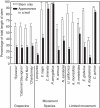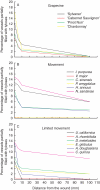Xylem structure of four grape varieties and 12 alternative hosts to the xylem-limited bacterium Xylella fastidious
- PMID: 21546428
- PMCID: PMC3119617
- DOI: 10.1093/aob/mcr106
Xylem structure of four grape varieties and 12 alternative hosts to the xylem-limited bacterium Xylella fastidious
Abstract
Background and aims: The bacterium Xylella fastidiosa (Xf), responsible for Pierce's disease (PD) of grapevine, colonizes the xylem conduits of vines, ultimately killing the plant. However, Vitis vinifera grapevine varieties differ in their susceptibility to Xf and numerous other plant species tolerate Xf populations without showing symptoms. The aim of this study was to examine the xylem structure of grapevines with different susceptibilities to Xf infection, as well as the xylem structure of non-grape plant species that support or limit movement of Xf to determine if anatomical differences might explain some of the differences in susceptibility to Xf.
Methods: Air and paint were introduced into leaves and stems to examine the connectivity between stem and leaves and the length distribution of their vessels. Leaf petiole and stem anatomies were studied to determine the basis for the free or restricted movement of Xf into the plant.
Key results: There were no obvious differences in stem or petiole vascular anatomy among the grape varieties examined, nor among the other plant species that would explain differences in resistance to Xf. Among grape varieties, the more tolerant 'Sylvaner' had smaller stem vessel diameters and 20 % more parenchyma rays than the other three varieties. Alternative hosts supporting Xf movement had slightly longer open xylem conduits within leaves, and more connection between stem and leaves, when compared with alternative hosts that limit Xf movement.
Conclusions: Stem--leaf connectivity via open xylem conduits and vessel length is not responsible for differences in PD tolerance among grape varieties, or for limiting bacterial movement in the tolerant plant species. However, it was found that tolerant host plants had narrower vessels and more parenchyma rays, possibly restricting bacterial movement at the level of the vessels. The implications of xylem structure and connectivity for the means and regulation of bacterial movement are discussed.
Figures




Similar articles
-
Xylem structure and connectivity in grapevine (Vitis vinifera) shoots provides a passive mechanism for the spread of bacteria in grape plants.Ann Bot. 2006 Sep;98(3):483-94. doi: 10.1093/aob/mcl124. Epub 2006 Jun 21. Ann Bot. 2006. PMID: 16790469 Free PMC article.
-
The effects of Pierce's disease on leaf and petiole hydraulic conductance in Vitis vinifera cv. Chardonnay.Physiol Plant. 2009 Aug;136(4):384-94. doi: 10.1111/j.1399-3054.2009.01231.x. Epub 2009 May 11. Physiol Plant. 2009. PMID: 19470095
-
Xylem-dwelling pathogen unaffected by local xylem vessel network properties in grapevines (Vitis spp.).Ann Bot. 2024 Apr 23;133(4):521-532. doi: 10.1093/aob/mcae016. Ann Bot. 2024. PMID: 38334466 Free PMC article.
-
Paradigms: examples from the bacterium Xylella fastidiosa.Annu Rev Phytopathol. 2013;51:339-56. doi: 10.1146/annurev-phyto-082712-102325. Epub 2013 May 17. Annu Rev Phytopathol. 2013. PMID: 23682911 Review.
-
The biology of xylem fluid-feeding insect vectors of Xylella fastidiosa and their relation to disease epidemiology.Annu Rev Entomol. 2004;49:243-70. doi: 10.1146/annurev.ento.49.061802.123403. Annu Rev Entomol. 2004. PMID: 14651464 Review.
Cited by
-
Vascular occlusions in grapevines with Pierce's disease make disease symptom development worse.Plant Physiol. 2013 Mar;161(3):1529-41. doi: 10.1104/pp.112.208157. Epub 2013 Jan 4. Plant Physiol. 2013. PMID: 23292789 Free PMC article.
-
Characterization of the Xylella fastidiosa PD1311 gene mutant and its suppression of Pierce's disease on grapevines.Mol Plant Pathol. 2017 Jun;18(5):684-694. doi: 10.1111/mpp.12428. Epub 2016 Aug 22. Mol Plant Pathol. 2017. PMID: 27388152 Free PMC article.
-
Assessment of diversity and genetic relationships of Neonectria ditissima: the causal agent of fruit tree canker.Hereditas. 2016 Jul 1;153:7. doi: 10.1186/s41065-016-0011-3. eCollection 2016. Hereditas. 2016. PMID: 28096769 Free PMC article.
-
Sulfur-Induced Resistance against Pseudomonas syringae pv. actinidiae via Triggering Salicylic Acid Signaling Pathway in Kiwifruit.Int J Mol Sci. 2021 Nov 24;22(23):12710. doi: 10.3390/ijms222312710. Int J Mol Sci. 2021. PMID: 34884527 Free PMC article.
-
Xylem cavitation susceptibility and refilling mechanisms in olive trees infected by Xylella fastidiosa.Sci Rep. 2019 Jul 3;9(1):9602. doi: 10.1038/s41598-019-46092-0. Sci Rep. 2019. PMID: 31270378 Free PMC article.
References
-
- Aloni R, Griffith M. Functional xylem anatomy in root–shoot junctions of six cereal species. Planta. 1991;184:123–129. - PubMed
-
- Alves E, Marucci CR, Lopes JRS, Leite B. Leaf symptoms on plum, coffee and citrus and the relationship with the extent of xylem vessels colonized by Xylella fastidiosa. Journal of Phytopathology. 2004;152:291–297.
-
- André JP. Organisation vasculaire des angiospermes: une vision nouvelle. Paris: Institut Nationale de la Recherche Agronomique (INRA); 2002.
-
- André JP, Catesson AM, Liberman M. Characters and origin of vessels with heterogenous structure in leaf and flower abscission zones. Canadian Journal of Botany. 1999;77:253–261.

